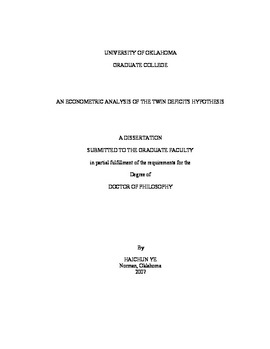| dc.contributor.advisor | Grier, Kevin, | en_US |
| dc.contributor.author | Ye, Haichun. | en_US |
| dc.date.accessioned | 2013-08-16T12:20:54Z | |
| dc.date.available | 2013-08-16T12:20:54Z | |
| dc.date.issued | 2007 | en_US |
| dc.identifier.uri | https://hdl.handle.net/11244/1256 | |
| dc.description.abstract | In the end I also extend similar analysis to five OECD countries and show that, in all five selected OECD countries, there is a fairly tenuous connection between the current account balance and the government budget balance in both the long run and short run. | en_US |
| dc.description.abstract | Since my estimation methods depart greatly from the usual methods employed in the literature, I then compare the preferred model to a homosekdastic demeaned VAR, a differenced VAR and a level VAR to explain how I get these results. It turns out that previous findings are less reliable due to their failure to take account of the presence of both break stationarity and conditional heteroskedasticity. | en_US |
| dc.description.abstract | Given the short-run twin relationship between the US government budget deficits and current account deficits, I further examine whether their relation is causal. While the causality-in-mean tests uncover a unidirectional causality from the government budget balance to the current account balance, the causality-in-variance tests indicate no causal relation between their volatilities at all. | en_US |
| dc.description.abstract | This study empirically revisits the twin deficits debate in the United States over the period from 1948:1 to 2005:1. New econometric techniques are employed in this study to formally address the problems of break stationarity and conditional heteroskedasticity in the series under study. | en_US |
| dc.description.abstract | Using the multiple structural break analysis recently developed by Bai and Perron, I show, for the first time, that the US current account balance and government budget balance series are actually stationary around an infrequently shifting mean. A further comparison between the breakpoints in these two series reveals that there is no long-run relationship between the US current account balance and government budget balance at all. | en_US |
| dc.description.abstract | To investigate the short-run relationship between these two series, I remove the shifting means from the series and use the demeaned series to estimate a multivariate VAR-GARCH model which can capture the conditional heteroskedasticity presented in the data. The generalized impulse response functions and variance decompositions on the basis of the multivariate VAR-GARCH model suggest that shocks to the US government budget balance do have strong positive effects on current account balance in the short run. This finding is quite robust to different model specifications. | en_US |
| dc.format.extent | ix, 103 leaves : | en_US |
| dc.subject | Budget deficits United States. | en_US |
| dc.subject | Balance of payments United States. | en_US |
| dc.subject | Economics, General. | en_US |
| dc.title | An econometric analysis of the twin deficits hypothesis. | en_US |
| dc.type | Thesis | en_US |
| dc.thesis.degree | Ph.D. | en_US |
| dc.thesis.degreeDiscipline | Department of Economics | en_US |
| dc.note | Adviser: Kevin Grier. | en_US |
| dc.note | Source: Dissertation Abstracts International, Volume: 68-10, Section: A, page: 4406. | en_US |
| ou.identifier | (UMI)AAI3283842 | en_US |
| ou.group | College of Arts and Sciences::Department of Economics | |
